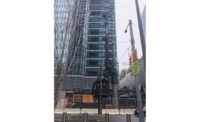Large pneumatic bags designed to contain blasts from improvised explosive devices are finding a peaceful application in Egypt, propping the crumbling interior of the nation’s oldest pyramid. When inflated, an array of the 1.5-meter-tall bags will allow workers safely to stabilize the fractured interior roof of the subterranean burial chamber, itself buried under the ancient stone heap that forms the Pyramid of Djoser, south of Cairo.
Built nearly 4,900 years ago in the reign of Djoser, the first king of the Third dynasty, the structure is the world’s oldest major stone monument, according to Zahi Hawass, secretary general of Egypt’s Supreme Council of Antiquities. “From this place, architecture was created,” he says.
Also called the Step Pyramid, the crumbling pile dominates a burial complex at Saqqara, on the west bank of the River Nile. The 62.5-m-tall pyramid, which has a 121 x 109-m footprint, has suffered from surface erosion and countless internal collapses. The most recent assault on the vulnerable structure was Cairo’s 1992 earthquake, centered near the site.
Until the Council’s current $5-million restoration project started in 2008, more than 50 tonnes of stonework rubble from roof collapses in the 30-m-tall, 8-m-square burial chamber covered the precious sarcophagus. Made with granite quarried some 800 kilometers away at Aswan, the sarcophagus, which is empty after early plundering, rests on six stone pillars.
Structurally, “the problem seems to be that there is a vertical plane of failure through the pyramid,” says Richard Swift, partner in SFK Consulting Ltd., Southampton, U.K. “In a seismic event, you’d get movement between the two planes,” he adds.
Buried deep in the pyramid just below ground level, the cave-like chamber has suffered internal collapses over time that have scooped out a roughly 3-m-tall, unstable dome-shaped void in the internal roof. Local workers have largely cleared the chamber, dragging rubble out through some of the pyramid’s 5.6 km of tunnels and shafts. A restoration crew with Cairo-based Elshoragi Contractor Ltd. has installed a deck on scaffolding some 1.5 m below the chamber’s original roof level.
To support the frail domed roof from this platform, Elshoragi subcontracted Cintec International Ltd., Newport, Wales, supported by the design firm SFK. With global sales of around $7.5 million, Cintec has carved out a business including blast engineering equipment and services. Its products include Waterwall, a range of fabric bags designed to contain explosions.
The polyvinyl chloride-coated bags are internally reinforced to retain their shape when filled with energy-absorbing water. For positioning, the bags are partially inflated with air, which is displaced as water is pumped in.
For the pyramid, the bags will be filled only with air. Cintec has made and tested 1-m-dia bags that are 1.5 m tall, each able to support a load of three tonnes, says Peter James, the firm’s co-owner and managing director. Cintec began shipping equipment from Wales early this month, aiming to complete its project around the end of March.
Workers will spread 11 bags over the temporary deck and inflate them to prop the roof. With the bags in place, SFK will survey the rock and help develop remedies for the roof. “It’s been regarded as an unsafe structure and nobody has been allowed in,” says Swift. The final form of the roof has yet to be determined.
Meanwhile, Cintec’s team will clear loose rubble, grout the chamber’s dome and attach a mesh lining. To secure the roof, the team will install special stainless steel anchors, generally two centimeters in diameter, up to 6 m into the body of the pyramid, says James.
The anchors supplied by Cintec are enclosed in woven fabric socks to prevent grout leaching into surrounding voids. The system allows air to be extracted from the anchor bore hole’s closed end. That creates a partial vacuum to suck grout into place at reduced positive pumping pressure to prevent rock fracturing, explains James.
Apart from the roof support work, staff of the Supreme Council of Antiquities and Elshoragi are doing the actual conservation work, says Hawass.
Having spent much time clambering around the pyramid, discovered by a local scientist in 1954, Hawass is delighted by work to undo erosion and damage from collapses traced back some 2,500 years. On the surface, the pyramid’s north, south and east sides have been restored, leaving the west face and the interior work. “We do not know how long the work will take. You never know!” says Hawass.








Post a comment to this article
Report Abusive Comment